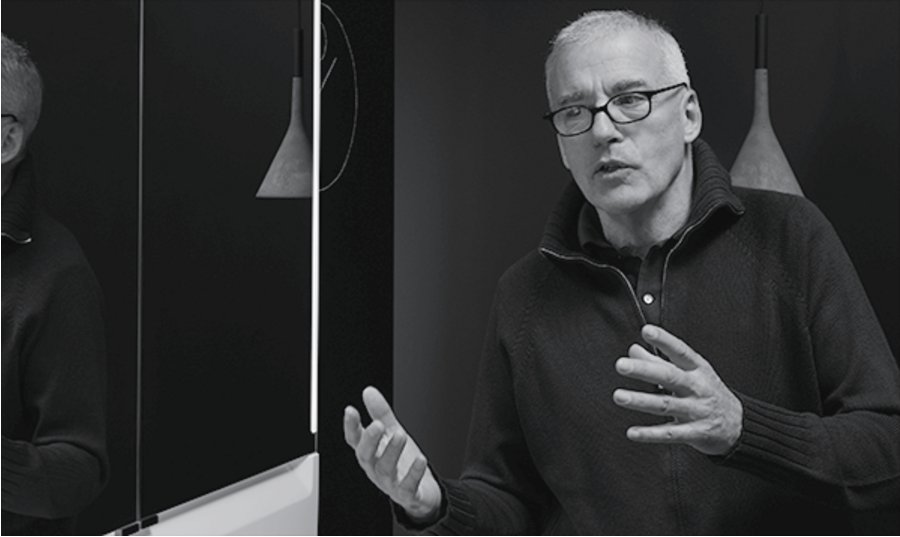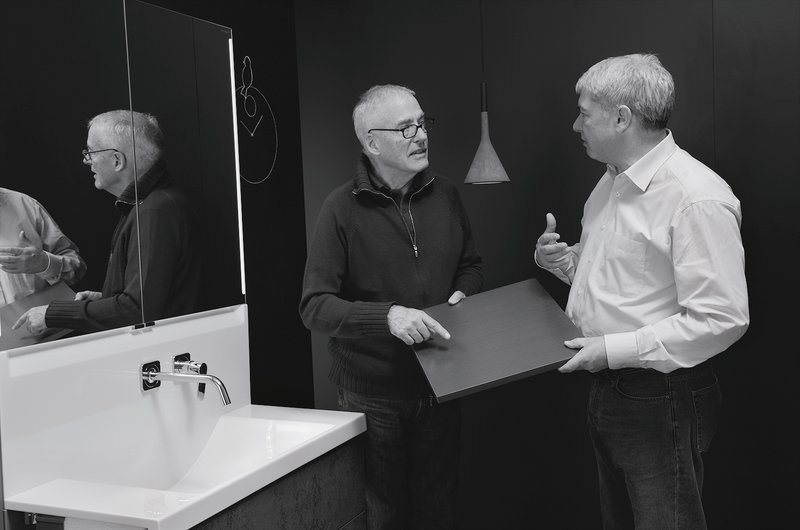Interview Marc Sadler: “This is only the first step"

Above: Marc Sadler explains Conceptwall. Right: Marc Sadler in discussion with burgbad-ceo Jörg Loew. Photos: burgbad
Bathroom furniture specialist Burgbad is known for its broad spectrum of washstand solutions and mirror cabinets, for solitaire collections and the architectural furniture range rc40. The new system Cconceptwall is a modular programme that integrates a wide range of different functions. It is about to blur the boundaries between the washstand and furniture. Its high degree of individualisability makes it an extremely flexible product for many different areas, as well as for many different target groups. From melamine to high-gloss acrylic, from colour to wooden finishes – the system has it all.
This project is the result of burgbad's collaboration with one of the most renowned designers of Europe's creative scene: Marc Sadler. The Frenchman started his career as a pioneer in the sporting equipment sector. He has created clothing, kitchens and irons, worked in studios in New York, Hong Kong, Taiwan and Venice and currently lives and works in Milan. Having mainly won laurels for his luminaires Twiggy, Mite (both for Foscarini) and Drop (Flos) in recent years, he threw himself into the project for Burgbad with great dedication, realising that it not only called for inventive creativity but for holistic, entrepreneurial thinking as well. As if to prove that he is an all-rounder, he created CConceptwall as a chameleon-like, highly variable "wall in front of the wall" – a piece of "real industrial design". During a meeting at the photo studio, Marc Sadler explained the background to the product that was the star of the session.
Cconceptwall isn't just a piece of furniture, it's about things like lighting and modularity as well. What exactly was your approach to the development of this product?
Light was actually one of the aspects. But only one of several. When Burgbad came to me and we were thinking about what we would like to do, we didn't talk about a piece of furniture, we talked about a platform. It wasn't about issues like colour and aesthetics; instead we thought about the efficient use of water, about clever use of storage space, and about the positioning of several lights instead of just one lamp, because the user needs different kinds of light at different times of day or night. At some point it was obvious that we weren't talking about a piece of furniture, but about an integral, holistic project.
Once the initial idea was born, what was it like to suddenly find yourself facing the challenge of such a complex project?
The product we had in mind suddenly became a kind of machine. What we see now is really only the first step. Cconceptwall is a genuine team project, an experiment in which we all learned a lot from one another. In the end, we actually had to stop ourselves and deliberately restrict ourselves because we had so many ideas, so many wheels we'd like to turn. But we decided we would only launch one initial part to start with and learn from it before we complete any further modules.
You're obviously good at thinking in systems – are you particularly fond of systems?
No, not always. But you have to be careful not to end up being pigeonholed because people like putting stickers on your back. The thing with systems is that they're not necessarily an easy assignment. You can't just make sculptures, and that's why a lot of my colleagues don't want anything to do with them. It's a very complex task and you have to work with the company as a team. I can't just sell them any old system because they already have their own. So you have to integrate yourself, and that's not always easy. It's easier to create a monument or a mausoleum, something big and beautiful, something you might win an award for before you die. But I think it's important to concern yourself with this bottom-line way of thinking too, and be able to work at a broader-based level.
What was the crucial factor in the development process – the design, the functionality or the economic side of things?
We gave equal consideration to all the factors. There were no taboos, not even when it came to the price. We made decisions about the quality of the light, the usage properties and the noise – because we don't like doors that make a noise when you close them. Installation was an issue too. I wasn't aware that anything like pre-wall installation for the bathroom was available on the German market. We adapted to the market. At the same time, with CConceptwall, we also wanted to move away from the usual standard walls.
Will this solution also be compatible with an altered bathroom culture?
Even today, the bathroom isn't the same as it was during our parents' generation. It's become much more of a place in its own right, and it actually has to accommodate two bathrooms: a functional bathroom and a mood bathroom. In the latter we want to pamper ourselves – for instance with good light for shaving or getting ready for a visit to the theatre, and with soft light for when I come back in the middle of the night and am a bit afraid of getting too good a look at myself. So I need lighting that I can change.
So Cconceptwall adapts to both mood-related and functional needs – is that all?
No, it's about the underlying concept as well. Cconceptwall is a machine, but an invisible one. It has a front, an outer skin if you like, which has to adapt to lots of different tastes in terms of architecture and decoration. But underneath this skin, it's always the same product.
So it's a product that will sell for a long time – on the manufacturer's side – and stay put for a long time – on the consumer's side – with the result that both sides will have a lasting benefit. That's one form of sustainability, wouldn't you say?
Of course. Cconceptwall has a kind of invisible intelligence, and that allows the product to evolve as the years pass. It will even change the way the sales force thinks: they won't be selling a finished product any more, but a system that can be tailored to the customer's needs and has to be promoted accordingly.
But that calls for a thorough understanding of the system and all the possibilities it offers…
Yes, but that's also a real opportunity: thanks to the product's great versatility, there's less likelihood of losing a sale, because it allows you to offer every customer something that suits him. I think Cconceptwall represents an opportunity for convincing product solutions, for fostering the relationship with the customer and for new business.
As a designer, how did you become so aware of the problems facing the sales force and the market?
Ultimately it's all about the needs of the people who use a bathroom. Obviously as a designer I bring my own ideas to an assignment, but in this case I had to fall back on the company's knowledge as well. So Burgbad took me to visit a whole series of its partners who, although they are in competition with one another, all told me the same thing: "We want to be successful with you and for you, but to do that we need answers and solutions to concrete problems. And we won't get those answers and solutions if you limit yourselves too much by focusing on a little box called furniture." We encountered a great deal of enthusiasm and were confronted with a clear analysis of the problems – to which I hope we've now found a potential answer.
This was pretty much the first project of this kind you've done for the sanitary sector. What insights have you gained from your collaboration with Burgbad?
The project really was totally new territory for me. But the experience of working with a company that is so sensitive to the importance of quality and that solves the technical problems before it presents a product to the public was new for me too. It might be a cliché, but often when we go to the Salone del Mobile with some famous brand or other, you only really see a beautiful mock-up and nobody knows whether the product will actually ever go into production. That's not the case here. We had to make certain choices and we did – in advance.
Where exactly does the difference lie – in the design or in the corporate culture?
Both. Here we are talking about industrial design, we are talking about real design – it is not a piece of sculpture. Burgbad really fulfills the needs of the market and has the necessary competence in many different respects – whether you're talking about marketing, design, talent or business. And I believe Burgbad has the potential to build credibility when it comes to the field of across-the-board bathroom equipment. After all, we don’t buy a car by buying the wheel, then buying the seats – we buy a complete, compact car. This is not happening in the bathroom today. But now, at Burgbad, they have this chance, and I am very willing to work on it as well. Maybe it is not going to be a total bathroom, but a big part of it – yes!
Let's stick with the car analogy – here too, it's the chassis that's responsible for the car's character and not the platform. In the case of Cconceptwall, the system remains in the background and the front shows a very individual face. So does individuality evolve on the basis of a system?
That was our aim. There are two products – one product underneath and one on the front page. And the front page could portray anything.
One final question: what is your own bathroom like?
I live in a big family and everybody wants to feel at home in the bathroom, so there are lots of compromises. But there's a nice side to that as well. One part of the space is structured by the kitchen modules I used to design for Boffi, with an antique mirror hanging next to them, whereas the lamps are high-tech and we have a big shower lined with mosaic tiles. It's a kind of fusion between various things – half professional, half cosy.
